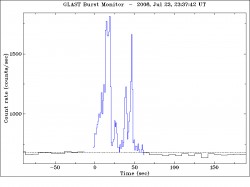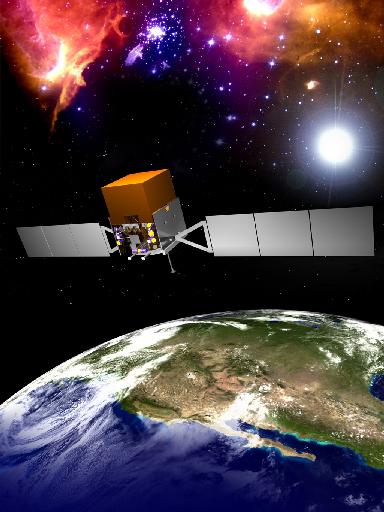[/caption]
After a 60-day checkout period, science operations have begun in earnest for GLAST, the Gamma ray Large Area Space Telescope, which is now surveying the gamma-ray sky. Launched on June 11, 2008, the GLAST spacecraft has been undergoing calibrations of the two instruments on board, the LAT (Large Area Telescope) and the GBM (GLAST Burst Monitor) — more details on the instruments in a moment. But during the checkout phase both instruments made significant observations of gamma rays. “Given that these detections were made with just the engineering data observations, the future is full of promise, and we are very excited,” said Dr. Steve Ritz, GLAST Project Scientist in his GLAST blog. At the end of August, there will be a formal release of the first-light images taken by the spacecraft. Also at that time, NASA will rename the observatory. I don’t know about you, but I’m sort of attached to the name “GLAST.” But it will be interesting to find out its new, official name.
In June, LAT detected two extraordinarily bright, flaring sources in space, which scientists believe are very likely supermassive black hole systems at the cores of active galaxies, located far across the universe, but incredibly bright. Additionally, by the end of July, the GBM had detected 12 gamma ray bursts.
“We are thrilled to be detecting gamma-ray bursts so early in the mission. GLAST and the GBM are off to a great start!” said Charles “Chip” Meegan, GBM principal investigator at NASA’s Marshall Space Flight Center, Huntsville, Ala. “The detectors are working well and we’re really pleased with how the instrument is working. That said, we’re using this checkout period to scrutinize the data coming down from the detectors and fine tune flight and ground software and our daily operational processes.”

The LAT detects gamma rays and is able to make gamma ray images of astronomical objects. The GBM is designed to observe gamma ray bursts, which are sudden, brief flashes of gamma rays that occur about once a day at random positions in the sky. The GBM has such a large field-of-view that it will be able to see bursts from over 2/3 of the sky at one time. The observations made by GBM were verified by the Swift Telescope, another space telescope that can swiftly skew around to view a gamma ray burst.
NASA has a tradition of renaming spacecraft after a successful launch, and with GLAST they decided to wait until the “first light” images are released. Any guesses on what the new name will be?
Source: GLAST blog


I, too, am sort of attached to the current GLAST moniker. But, please no James Webb (a NASA administrator) telescope. Of course Compton was taken by GRO, Lyman Spitzer was somehow linked to the Infrared Space Telescope Facility( SIRTF) when in 1946 he made the original proposal for a orbiting space telescope( which became the Hubble Space Telescope, go fig). Chandrasekhar was linked with AXAF( now the Chandra X-ray Observatory) & seems rather fitting. How about the (Philip) Morrison Gamma-ray Telescope, in recognition of his longtime work in high energy physics & astrophysics & the Manhattan Project. Seems fitting for such a well known, widely read, and eloquent scientist.
Also meant to mention Einstein X-ray satellite (HEAO-B), Wilhelm Rontgen (ROSAT X-ray satellite) and the Rossi X-ray Timing Explorer (RXTE) and there are surely other worthy astronomy satellites named for famous scientists that I’ve missed.
And I thought they totally forgot about the renaming part of the mission.
Nancy —
“In June, LAT detected two extraordinarily bright, flaring sources in space, which scientists believe are very likely supermassive black hole systems at the cores of active galaxies, located far across the galaxy, but incredibly bright. ” Erm, isn’t that “. . . located far across the *universe”, but incredibly bright”? Otherwise, great article. 🙂
How about naming it after Richard Phillips Feynman. He was an amazing person who inspired so many. His impact on education and science will be felt for many many years.
Will the GLAST images be public domain? They should be, but lately it seems that NASA has acquired the belief that as long as there’s some third party not subject to the waiver of copyright distantly involved, they don’t have to make their images free content. This issue is scarcely talked about, but it’s far more important than what they’re going to name the thing.
Thanks Yael for noting the typo! It’s been fixed.
Nancy
Why don’t they take the name GLAST. It sounds good, doesn’t it ?
I sort of like the idea of honoring the pioneers of cosmology and astronomy by naming things like the GLAST after them. Hearing their names every time new data is observed reminds us of our roots in greatness.
I agree with JamesB on this one. By honoring those that made significant contributions to their respective fields of cosmology, astrophysics & space science, we are reminded of those that came before, and whose research laid the groundwork for today’s scientists. I only made mention of the attachment of NASA administrator James Webb to the forthcoming ‘James Webb Space Telescope’ as I see no scientific connection of his no doubt valuable contribution to NASA and the IR science that the JWST will make great contributions to. Seems like a political decision to me, but will not diminish by one iota the scientific data this observatory can & will produce.
If you ever want to read a reader’s feedback 🙂 , I rate this post for four from five. Detailed info, but I have to go to that damn google to find the missed parts. Thank you, anyway!